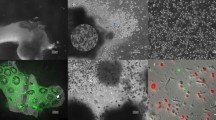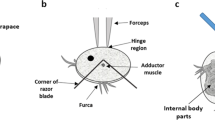Abstract
In the context of global change, symbiotic cnidarians are largely affected by seawater temperature elevation leading to symbiosis breakdown. This process, also called bleaching, is triggered by the dysfunction of the symbiont photosystems causing an oxidative stress and cell death to both symbiont and host cells. In our study, we wanted to elucidate the intrinsic capacity of isolated animal cells to deal with thermal stress in the absence of symbiont. In that aim, we have characterized an animal primary cell culture form regenerating tentacles of the temperate sea anemone Anemonia viridis. We first compared the potential of whole tissue tentacle or separated epidermal or gastrodermal monolayers as tissue sources to settle animal cell cultures. Interestingly, only isolated cells extracted from whole tentacles allowed establishing a viable and proliferative primary cell culture throughout 31 days. The analysis of the expression of tissue-specific and pluripotency markers defined cultivated cells as differentiated cells with gastrodermal origin. The characterization of the animal primary cell culture allowed us to submit the obtained gastrodermal cells to hyperthermal stress (+ 5 and + 8 °C) during 1 and 7 days. Though cell viability was not affected at both hyperthermal stress conditions, cell growth drastically decreased. In addition, only a + 8 °C hyperthermia induced a transient increase of antioxidant defences at 1 day but no ubiquitin or carbonylation protein damages. These results demonstrated an intrinsic resistance of cnidarian gastrodermal cells to hyperthermal stress and then confirmed the role of symbionts in the hyperthermia sensitivity leading to bleaching.








Similar content being viewed by others
References
Barnay-Verdier S, Dall’Osso D, Joli N, Olivré J, Priouzeau F, Zamoum T, Merle PL, Furla P (2013) Establishment of primary cell culture from the temperate symbiotic cnidarian, Anemonia viridis. Cytotechnology 65(5):697–704
Brown BE, Downs CA, Dunne RP, Gibb SW (2002) Exploring the basis of thermotolerance in the reef coral Goniastrea aspera. Mar Ecol Prog Ser 242:119–129
Buss H, Chan TP, Sluis KB, Domigan NM, Winterbourn CC (1997) Protein carbonyl measurement by a sensitive ELISA method. Free Radic Biol Med 23(3):361–366
Cai X, Zhang Y (2014) Marine invertebrate cell culture: a decade of development. J Oceanogr 70(5):405–414
Davy SK, Lucas IAN, Turner JR (1996) Carbon budgets in temperate anthozoan-dinoflagellate symbioses. Mar Biol 126(4):773–783
Domart-Coulon IJ, Elbert DC, Scully EP, Calimlim PS, Ostrander GK (2001) Aragonite crystallization in primary cell cultures of multicellular isolates from a hard coral, Pocillopora damicornis. Proc Natl Acad Sci 98(21):11885–11890
Domart-Coulon I, Tambutté S, Tambutté E, Allemand D (2004) Short term viability of soft tissue detached from the skeleton of reef-building corals. J Exp Mar Biol Ecol 309(2):199–217
Downs CA, Fauth JE, Halas JC, Dustan P, Bemiss J, Woodley CM (2002) Oxidative stress and seasonal coral bleaching. Free Radic Biol Med 33(4):533–543
Downs CA, McDougall KE, Woodley CM, Fauth JE, Richmond RH, Kushmaro A, Gibb SW, Loya Y, Ostrander GK, Kramarsky-Winter E (2013) Heat-stress and light-stress induce different cellular pathologies in the symbiotic dinoflagellate during coral bleaching. PLoS One 8(12):e77173
Dunn SR, Schnitzler CE, Weis VM (2007) Apoptosis and autophagy as mechanisms of dinoflagellate symbiont release during cnidarian bleaching: every which way you lose. Proc R Soc B Biol Sci 274(1629):3079–3085
Ferrier-Pages C, Tambutte E, Zamoum T, Segonds N, Merle PL, Bensoussan N, Allemand D, Garrabou J, Tambutte S (2009) Physiological response of the symbiotic gorgonian Eunicella singularis to a long-term temperature increase. J Exp Biol 212(18):3007–3015
Frank U, Rabinowitz C, Rinkevich B (1994) In vitro establishment of continuous cell cultures and cell lines from ten colonial cnidarians. Mar Biol 120(3):491–499
Franklin DJ, Berges JA (2004) Mortality in cultures of the dinoflagellate Amphidinium Carterae during culture senescence and darkness. Proc Biol Sci 271(1553):2099–2107
Fransolet D, Roberty S, Plumier J-C (2014) Impairment of symbiont photosynthesis increases host cell proliferation in the epidermis of the sea anemone Aiptasia pallida. Mar Biol 161(8):1735–1743
Furla P, Allemand D, Orsenigo M-N (2000) Involvement of H+-ATPase and carbonic anhydrase in inorganic carbon uptake for endosymbiont photosynthesis. Am J Phys Regul Integr Comp Phys 278:R870–R881
Ganot P, Moya A, Magnone V, Allemand D, Furla P, Sabourault C (2011) Adaptations to endosymbiosis in a cnidarian-dinoflagellate association: differential gene expression and specific gene duplications. PLoS Genet 7(7):e1002187
Helman Y, Natale F, Sherrell RM, LaVigne M, Starovoytov V, Gorbunov MY, Falkowski PG (2008) Extracellular matrix production and calcium carbonate precipitation by coral cells in vitro. Proc Natl Acad Sci 105(1):54–58
Higashikubo R, White RA, Roti Roti JL (1993) Flow cytometric BrdUrd-pulse-chase study of heat-induced cell-cycle progression delays. Cell Prolif 26(4):337–348
Hildebrandt B, Wust P, Ahlers O et al (2002) The cellular and molecular basis of hyperthermia. Crit Rev Oncol Hematol 43(1):33–56
Hoegh-Guldberg O (1999) Climate change, coral bleaching and the future of the world’s coral reefs. Mar Freshw Res 50(8):839
Hoegh-Guldberg O, Mumby PJ, Hooten AJ, Steneck RS, Greenfield P, Gomez E, Harvell CD, Sale PF, Edwards AJ, Caldeira K, Knowlton N, Eakin CM, Iglesias-Prieto R, Muthiga N, Bradbury RH, Dubi A, Hatziolos ME (2007) Coral reefs under rapid climate change and ocean acidification. Science 318(5857):1737–1742
Huete-Stauffer C, Valisano L, Gaino E, Vezzulli L, Cerrano C (2015) Development of long-term primary cell aggregates from Mediterranean octocorals. In Vitro Cell Dev Biol Anim 51(8):815–826
Khalesi MK (2008) Cell cultures from the symbiotic soft coral Sinularia flexibilis. In Vitro Cell Dev Biol Anim 44(8-9):330–338
Kopecky EJ, Ostrander GK (1999) Isolation and primary culture of viable multicellular endothelial isolates from hard corals. In Vitro Cell Dev Biol Anim 35(10):616–624
Kühl NM, Rensing L (2000) Heat shock effects on cell cycle progression. Cell Mol Life Sci 57(3):450–463
Leclère L, Jager M, Barreau C, Chang P, le Guyader H, Manuel M, Houliston E (2012) Maternally localized germ plasm mRNAs and germ cell/stem cell formation in the cnidarian Clytia. Dev Biol 364(2):236–248
Lecointe A, Cohen S, Gèze M, Djediat C, Meibom A, Domart-Coulon I (2013) Scleractinian coral cell proliferation is reduced in primary culture of suspended multicellular aggregates compared to polyps. Cytotechnology 65(5):705–724
Lesser MP (1997) Oxidative stress causes coral bleaching during exposure to elevated temperatures. Coral Reefs 16(3):187–192
Lesser MP (2006) Oxidative stress in marine environments: biochemistry and physiological ecology. Annu Rev Physiol 68(1):253–278
Lesser MP (2011) Coral bleaching: causes and mechanisms. In: Dubinsky Z, Stambler N (eds) Coral reefs: an ecosystem in transition. Springer Netherlands, Dordrecht, pp 405–419
Lesser MP, Stochaj WR, Tapley DW, Shick JM (1990) Bleaching in coral reef anthozoans: effects of irradiance, ultraviolet radiation, and temperature on the activities of protective enzymes against active oxygen. Coral Reefs 8(4):225–232
Mercurio S, Di Benedetto C, Sugni M, Candia Carnevali MD (2014) Primary cell cultures from sea urchin ovaries: a new experimental tool. In Vitro Cell Dev Biol Anim 50(2):139–145
Morabito R, Marino A, Dossena S, La Spada G (2014) Nematocyst discharge in Pelagia noctiluca (Cnidaria, Scyphozoa) oral arms can be affected by lidocaine, ethanol, ammonia and acetic acid. Toxicon 83:52–58
Moya A, Ganot P, Furla P, Sabourault C (2012) The transcriptomic response to thermal stress is immediate, transient and potentiated by ultraviolet radiation in the sea anemone Anemonia viridis. Mol Ecol 21(5):1158–1174
Murate M, Kishimoto Y, Sugiyama T et al (1997) Hydra regeneration from recombined ectodermal and endodermal tissue. J Cell Sci 110:1919–1934
Naguib YMA (2000) A fluorometric method for measurement of oxygen radical-scavenging activity of water-soluble antioxidants. Anal Biochem 284(1):93–98
Papenfuss EJ, Bokenham NAH (1939) The fate of the ectoderm and endoderm of hydra when cultured independently. Biol Bull 76(1):1–6
Passamaneck YJ, Martindale MQ (2012) Cell proliferation is necessary for the regeneration of oral structures in the anthozoan cnidarian Nematostella vectensis. BMC Dev Biol 12:1
Pey A, Zamoum T, Allemand D, Furla P, Merle PL (2011) Depth-dependant thermotolerance of the symbiotic Mediterranean gorgonian Eunicella singularis: evidence from cellular stress markers. J Exp Mar Biol Ecol 404(1-2):73–78
Pey A, Zamoum T, Christen R, Merle PL, Furla P (2017) Characterization of glutathione peroxidase diversity in the symbiotic sea anemone Anemonia viridis. Biochimie 132:94–101
Putnam NH, Srivastava M, Hellsten U, Dirks B, Chapman J, Salamov A, Terry A, Shapiro H, Lindquist E, Kapitonov VV, Jurka J, Genikhovich G, Grigoriev IV, Lucas SM, Steele RE, Finnerty JR, Technau U, Martindale MQ, Rokhsar DS (2007) Sea anemone genome reveals ancestral eumetazoan gene repertoire and genomic organization. Science 317(5834):86–94
Puverel S, Tambutté E, Zoccola D et al (2005) Antibodies against the organic matrix in scleractinians: a new tool to study coral biomineralization. Coral Reefs 24(1):149–156
Rabinowitz C, Moiseeva E, Rinkevich B (2016) In vitro cultures of ectodermal monolayers from the model sea anemone Nematostella vectensis. Cell Tissue Res 366(3):693–705
Reyes-Bermudez A, Miller DJ (2009) In vitro culture of cells derived from larvae of the staghorn coral Acropora millepora. Coral Reefs 28(4):859–864
Richier S, Merle P-L, Furla P, Pigozzi D, Sola F, Allemand D (2003) Characterization of superoxide dismutases in anoxia- and hyperoxia-tolerant symbiotic cnidarians. Biochim Biophys Acta Gen Subj 1621(1):84–91
Richier S, Furla P, Plantivaux A et al (2005) Symbiosis-induced adaptation to oxidative stress. J Exp Biol 208(2):277–285
Richier S, Sabourault C, Courtiade J, Zucchini N, Allemand D, Furla P (2006) Oxidative stress and apoptotic events during thermal stress in the symbiotic sea anemone, Anemonia viridis. FEBS J 273(18):4186–4198
Richier S, Rodriguez-Lanetty M, Schnitzler CE, Weis VM (2008) Response of the symbiotic cnidarian Anthopleura elegantissima transcriptome to temperature and UV increase. Comp Biochem Physiol Part D Genomics Proteomics 3(4):283–289
Rinkevich B (1999) Cell cultures from marine invertebrates: obstacles, new approaches and recent improvements. J Biotechnol 70(1-3):133–153
Sabourault C, Ganot P, Deleury E, Allemand D, Furla P (2009) Comprehensive EST analysis of the symbiotic sea anemone, Anemonia viridis. BMC Genomics 10(1):333
Schmid V, Ono S, Reber-Müller S (1999) Cell-substrate interactions in Cnidaria. Microsc Res Tech 44(4):254–268
Trench RK (1993) Microalgal-invertebrate symbioses-a review. Endocytobiosis Cell Res 9:135–175
Vandepas LE, Warren KJ, Amemiya CT, Browne WE (2017) Establishing and maintaining primary cell cultures derived from the ctenophore Mnemiopsis leidyi. J Exp Biol. https://doi.org/10.1242/jeb.152371
Weis VM (2008) Cellular mechanisms of cnidarian bleaching: stress causes the collapse of symbiosis. J Exp Biol 211(19):3059–3066
Acknowledgments
Authors greatly acknowledge Laura Hedon for her precious technical help and Thamilla Zamoum for RT-PCR technical advises. Authors also thank Maeva Gesson and Magali Mondin of the PRISM (Platform of Resources in Imaging and Scientific Microscopy, Institut de Biologie Valrose, Université Nice Sophia Antipolis), Matthieu Rouleau and Aldine Amiel for scientific discussions. Authors are also grateful to Brigitte Poderini, for sea anemone maintenance in aquaria. We thank the editor and the reviewers for their useful criticisms, which helped us improve the manuscript.
Funding
This work was supported by a doctoral fellowship from the French ministère de l’Enseignement supérieur et de la Recherche (513-EDSFA021-2013) to PV and by research funding program from Université Nice Sophia Antipolis and Provence Alpes Côte d’Azur Region (MIRACLE project).
Author information
Authors and Affiliations
Corresponding author
Ethics declarations
Conflict of Interest
The authors declare that they have no conflict of interest.
Additional information
P. Furla and S. Barnay-Verdier share the seniorship position.
Electronic Supplementary Material
ESM 1
(DOCX 401 kb)
Rights and permissions
About this article
Cite this article
Ventura, P., Toullec, G., Fricano, C. et al. Cnidarian Primary Cell Culture as a Tool to Investigate the Effect of Thermal Stress at Cellular Level. Mar Biotechnol 20, 144–154 (2018). https://doi.org/10.1007/s10126-017-9791-3
Received:
Accepted:
Published:
Issue Date:
DOI: https://doi.org/10.1007/s10126-017-9791-3




